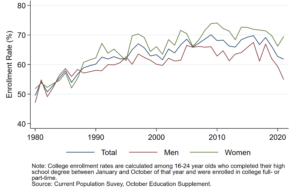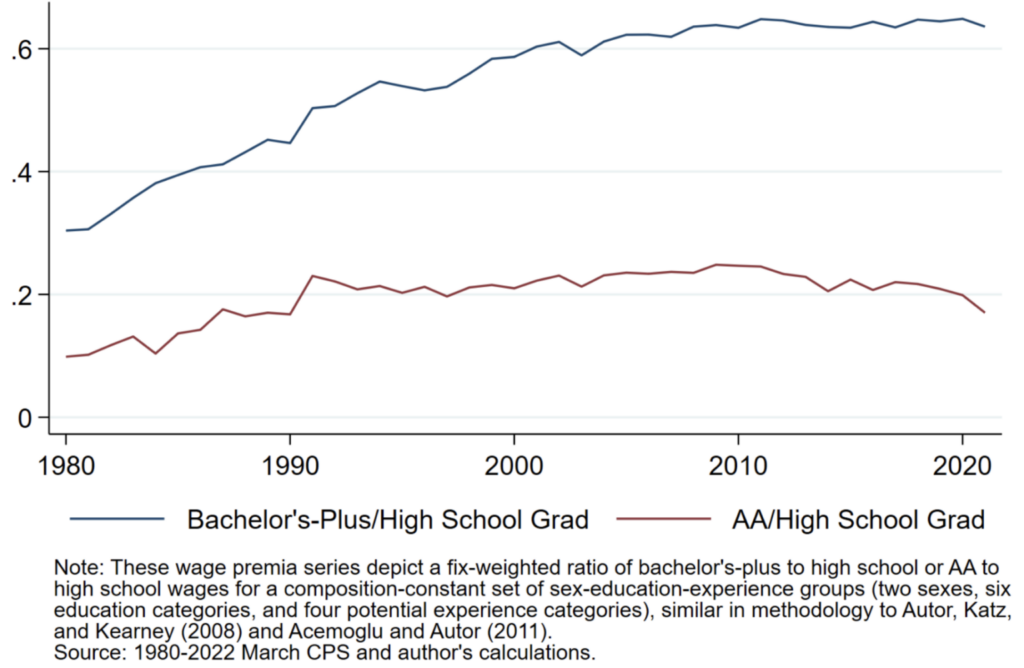
IN BRIEF: The College Wage Premium Through the COVID-19 Pandemic

IN BRIEF
COVID-related disruptions coupled with a tight labor market have led to a historic decline in college enrollment of recent high school graduates over the past three years. This drop, however, comes as the earnings premium for a college degree remains substantial and near decades-long highs. As globalization and technological advances fuel business demands for highly-skilled workers, improving college enrollment and completion rates is key to improving the American workforce’s competitiveness and families’ economic security.
WHAT TO KNOW
- In the Fall of 2022, there were 1.23 million fewer undergraduate students enrolled in college than there were just before the pandemic, according to estimates released in February 2023 by the National Student Clearinghouse Research Center. Although enrollment had been declining modestly before the pandemic, this most recent figure represents an 8% drop since the Fall of 2019.
- Research indicates that recent high school graduates have been delaying or foregoing college due to COVID-related disruptions to household finances and a strong labor market for workers without a college degree. Indeed, as shown in the figure below, the rate of recent high school graduates enrolling into college in the same year has declined from 66.1% in 2019 to 61.8% in 2022 – the lowest level since 2001. This decline in immediate enrollment was particularly large for men, reaching its lowest level (54.9%) since 1983. The enrollment report did find a 4.3% increase in the number of freshmen entering college, a sign that some students who delayed enrollment by a year or two are beginning to find their way back to college.
Figure 1. College Enrollment Rates of New High School Graduates

- Despite those initial encouraging signs, the large drop in college enrollment seen over the past three years is troubling because the return to a college degree remains near historic highs. Figure 2 extends previous estimates of college wage premia – that is, the difference in log annual earnings between those who have received a bachelor’s degree (or associate’s degree) and those who have not – through 2021. The BA/high school wage premium stood at 88% in 2021 and the AA/high school wage premium at 19%.
Figure 2. College Wage Premia, 1980-2021

- As argued in a recent AESG policy volume by Austan Goolsbee, Glenn Hubbard, Amy Ganz and Melissa Kearney, increasing educational attainment is key to both maintaining the competitiveness of the US economy and to improving households’ economic security. As globalization and advances in technology increase businesses’ demand for highly-skilled workers, adults with college degrees have an unemployment rate roughly half that of adults with a high school degree or less. Simulation exercises in Hershbein, Kearney, and Pardue (2020), find that a modest increase in educational attainment of 4 million BA holders and 4 million AA recipients would reduce the share of low income families by 15%.
THE BOTTOM LINE
Currently the earnings premium for workers with a BA stands at 90% and the premium for workers with an AA at 19%. Further increasing educational attainment will meet business demands for highly-skilled workers, fostering faster economic growth, while also reducing poverty. Yet, over the past three years, there has been a historic decline in college enrollment. Reversing this decline – and indeed increasing postsecondary enrollment and completion – will improve America’s long-term economic competitiveness and households’ economic security.